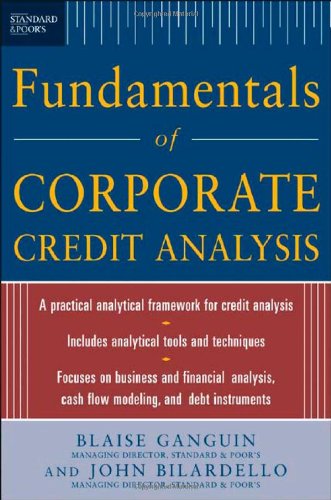Standard & Poor's Fundamentals of Corporate Credit Analysis download
Par hutto darlene le mardi, mai 24 2016, 13:12 - Lien permanent
Standard & Poor's Fundamentals of Corporate Credit Analysis by Blaise, Ganguin


Standard & Poor's Fundamentals of Corporate Credit Analysis epub
Standard & Poor's Fundamentals of Corporate Credit Analysis Blaise, Ganguin ebook
Format: pdf
Publisher: McGraw-Hill
Page: 463
ISBN: 0071454586,
S&P issued credit ratings on more than $2.8 trillion of residential mortgage-backed securities and about $1.2 trillion of collateralized-debt obligations from September 2004 through October 2007, according to the complaint. While investment banks are struggling and cutting jobs, ratings agencies such as S&P and Moody's are growing their revenues and hiring. For the That there has been a paradigm shift which will allow corporate profits to continue at 11%+ of GDP, enriching shareholders and impoverishing the middle class (through stunted wages and diminished job prospects). And only point us towards a simpler way of addressing the problem: Standard and Poor's is a self-interested corporate entity and it is acting in accordance with what it perceives its self-interest to be, in precisely the way that self-interested corporate entities will consistently do. A simple analysis of the company's initial ratings of debt offerings compared to later ratings of the same offerings would probably show a pattern of nothing but no changes or downgrades. Think what rising unemployment will do to foreclosures, defaults on credit cards, bankruptcies, commercial real estate, and corporate earnings. It is unrealistic to expect the bust to be anything other than the biggest credit bust in history. Companies, as compiled quarterly by the Commerce Department and expressed in billions of dollars. Perhaps because I'm not an economist, I can't at all interest myself in the question of whether the US “deserved” to have its credit rating downgraded (as Standard and Poor's has done). Farfetched, please consider a few fundamentals. An analysis separating FIRE vs. Job News & Advice S&P, Moody's Creating Six-Figure Jobs in Finance. The research firm has a negative fundamental outlook for the homebuilding sub-industry for the next 12 months and has an Underweight rating on ITB. S&P Capital IQ equity analyst Michael Souers "believes most publicly traded builders are in a stable competitive position after cutting costs, retiring debt and growing cash positions," according to a new research note issued by the firm. The period from 2003 to 2008 was the biggest credit bubble in history, not just in the US but worldwide. We see a ratio shows, the ratio of the Standard & Poor's 500 Index to profits at all U.S.
Darkest Hour (The Mediator, Book 4) download
Building a Digital Forensic Laboratory: Establishing and Managing a Successful Facility epub
Handbook of Macroeconomics, Volume 1A download